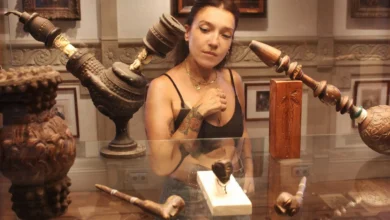The Role of Jumping Saddles in Equestrian Sports
Introduction
nnnnEquestrian sports have long held a special place in the hearts of riders and enthusiasts alike. The unique bond between horse and rider, coupled with the grace and power displayed in these disciplines, is truly awe-inspiring. One such equestrian sport that showcases this partnership, along with precision and athleticism, is show jumping. In the world of show jumping, the jumping saddle takes center stage, playing a pivotal role in ensuring the success and safety of the rider and horse. In this article, we will explore the significance of jumping saddles in equestrian sports, with a particular focus on show jumping, and delve into the various aspects that make these saddles indispensable for riders.
nnnnChapter 1: The Essence of Show Jumping
nnnn1.1. The Rider-Horse Connection: At the heart of show jumping lies the profound connection between rider and horse. This partnership is built on trust, communication, and a mutual understanding of each other’s cues and responses.
nnnn1.2. Precision and Agility: Show jumping is a sport that demands precision and agility. Riders and their horses must navigate a course filled with obstacles, including fences and combinations, requiring them to make split-second decisions and execute accurate maneuvers.
nnnn1.3. The Thrill of the Jump: The climax of every show jumping round is the jump itself. Riders and horses work in perfect harmony to clear these obstacles with grace and accuracy. The jumping saddle is instrumental in ensuring the rider’s stability during take-offs, mid-air moments, and landings, contributing to the safety and excellence of the partnership.
nnnnChapter 2: Anatomy of a Jumping Saddle
nnnnTo understand the role of jumping saddles in equestrian sports, it’s essential to explore the construction and design of these specialized saddles:
nnnn2.1. Seat: The seat of a jumping saddle is typically flatter and more forward than those of other saddle types. This design allows riders to maintain a balanced position over fences, a critical element for effective communication and balance during take-offs and landings.
nnnn2.2. Tree: The saddle tree, often crafted from materials like wood, fiberglass, or advanced composites, serves as the framework of the saddle. Jumping saddle trees are engineered for both strength and flexibility, allowing the saddle to conform to the horse’s back while retaining its shape.
nnnn2.3. Panels: Panels in a jumping saddle provide cushioning and support for the rider. These panels are designed to distribute the rider’s weight evenly, minimizing pressure points on the horse’s back and ensuring rider comfort and horse welfare.
nnnn2.4. Flaps: Flaps in a jumping saddle are designed to provide leg support and facilitate rider contact with the horse’s sides. They are typically more forward and shorter than those of other saddles, allowing for close contact and ease of communication with the horse.
nnnn2.5. Stirrups and Leathers: Jumping saddles feature stirrups and leathers designed to allow riders to maintain a secure and balanced position while jumping. Stirrups are often lightweight and provide a specific angle for the rider’s leg position, enhancing stability and communication with the horse.
nnnnChapter 3: The Crucial Role of Jumping Saddles
nnnnJumping saddles play a pivotal role in equestrian sports, ensuring the success and safety of both rider and horse:
nnnn3.1. Rider’s Stability: The jumping saddle provides the rider with a stable seat, allowing them to maintain balance and security during jumps. This stability is crucial for effective communication with the horse and executing precise maneuvers.
nnnn3.2. Horse Comfort: Ensuring the comfort of the horse is paramount in equestrian sports. A well-fitted jumping saddle, with proper panels and tree, ensures the horse remains comfortable and free from pressure points, enhancing the horse’s willingness to cooperate and contribute to the partnership.
nnnn3.3. Effective Communication: The close contact design of the jumping saddle facilitates effective communication between the rider and the horse. Subtle cues are relayed through the rider’s seat and legs, allowing for seamless cooperation between the two, essential for the precise execution of jumps.
nnnn3.4. Safety and Confidence: The jumping saddles offer riders a sense of safety and confidence, allowing them to tackle challenging jumps with assurance. This security promotes trust and a harmonious partnership between rider and horse, underpinning high-level performance.
nnnnChapter 4: The Importance of Quality Craftsmanship
nnnn4.1. Selecting a Reputable Brand: The choice of a jumping saddle from a reputable manufacturer is vital. Brands with a history of quality craftsmanship and expertise in equestrian sports are more likely to provide a saddle that meets the high standards of riders and horses.
nnnn4.2. Precision Stitching and Materials: The stitching and craftsmanship of jumping saddles are meticulous, ensuring durability and longevity while offering a touch of elegance and style.
nnnnChapter 5: Customization and Personalization
nnnn5.1. The World of Custom Saddles: Some riders prefer custom saddles tailored to their specific preferences and needs, providing them with a unique and personalized experience.
nnnn5.2. Engraving and Personalization: Engraving and personalization options add a touch of individuality and style to the saddle, enhancing the rider’s connection to their equipment.
nnnnChapter 6: Choosing the Right Jumping Saddle
nnnnSelecting the right jumping saddle is a personalized process, as each rider and horse combination is unique:
nnnn6.1. Seat Size and Fit: The size of the saddle seat should match the rider’s build and preferences. Riders should ensure they have enough room to move while maintaining a secure seat.
nnnn6.2. Tree Width: The width of the saddle tree must correspond to the shape and width of the horse’s back. A properly fitting tree ensures the saddle distributes weight evenly and does not create pressure points, promoting safety and comfort.
nnnn6.3. Flap Length: The length of the flaps should accommodate the rider’s leg length and position. Flaps that are too short or too long can affect rider balance and communication with the horse.
nnnn6.4. Brand and Quality: Choosing a jumping saddle from reputable manufacturers known for their quality craftsmanship is often a reliable choice. Research the reputation of saddle manufacturers and consider the build quality of the saddle.
nnnnChapter 7: The Future of Jumping Saddles
nnnnInnovations in technology and materials continue to influence the design and performance of jumping saddles. Riders can look forward to exciting developments that further enhance the role of these saddles in equestrian sports.
nnnnChapter 8: Conclusion
nnnnThe role of jumping saddles in equestrian sports, especially in show jumping, cannot be overstated. These specialized saddles are the bridge that connects rider and horse, ensuring that the partnership flourishes with precision, balance, and trust. Whether you’re a competitive show jumper, an avid equestrian, or a casual rider, the jumping saddle is your conduit to a world of elegance, athleticism, and the extraordinary partnership that defines equestrian sports. The legacy of jumping saddles in the world of riding is one of trust, precision, and the celebration of the bond between rider and horse that makes these sports truly exceptional.
n


